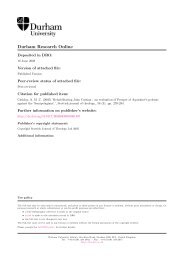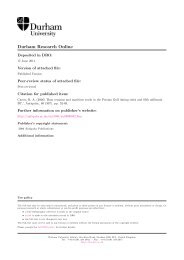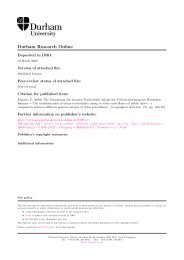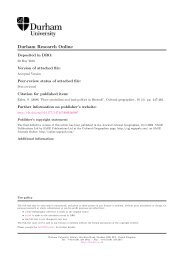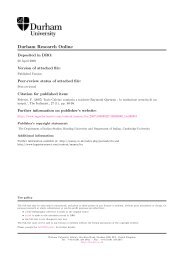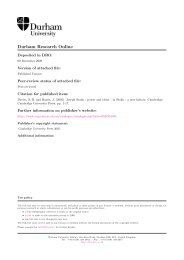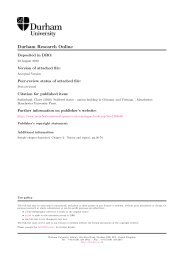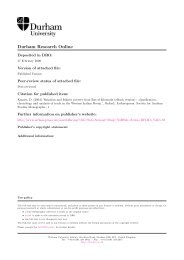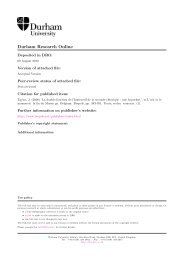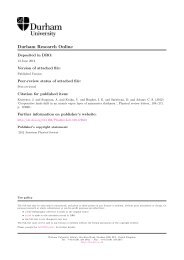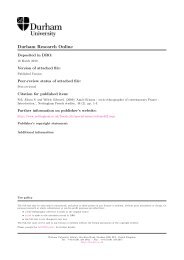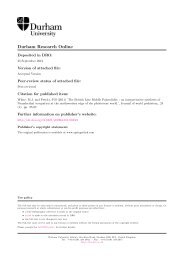Being-with as making worlds: the'second coming'of Peter Sloterdijk.
Being-with as making worlds: the'second coming'of Peter Sloterdijk.
Being-with as making worlds: the'second coming'of Peter Sloterdijk.
Create successful ePaper yourself
Turn your PDF publications into a flip-book with our unique Google optimized e-Paper software.
2006c) which plunges us into the desolation that incites a ‗diabolical Kantianism.‘<br />
The imperative of modernity, always more motion, for the sake of motion, h<strong>as</strong><br />
unle<strong>as</strong>hed a kinetic politics of acceleration that turns everything into an industrial<br />
w<strong>as</strong>teland. Appropriating Ernst Jünger‘s notion of mobilization (from his book Der<br />
Arbeiter [The Worker] (1932), and mixing it <strong>with</strong> Paul Virilio‘s dromology (1986)<br />
<strong>Sloterdijk</strong> calls for a critique of Europe and Modernity‘s cat<strong>as</strong>trophic political<br />
kinetics. It also brings to mind Heidegger‘s reflections on modernity and<br />
technology. It is this same orientation that informs his other two most explicitly<br />
political texts Im Selbe Boot [In the Same Boat] (1993b) and Falls Europa<br />
erwacht [If Europe Awakes] (1994), which call for a cosmopolitan ecological<br />
ethos of planetary co-existence, and that at the same time challenge Europe‘s<br />
intellectual insouciance (see also <strong>Sloterdijk</strong> 2005b). Even superficial readings of<br />
his most recent works will not fail to note the avowed anti-Eurocentric and anti-<br />
American tone, which is not motivated by either ressentiment or bad faith, but<br />
rather by a truly cosmopolitan and terrestrial ethos (<strong>Sloterdijk</strong> 2005a and 2007a).<br />
Indeed, <strong>Sloterdijk</strong> can be said to be articulating the ethos of a post-Imperial<br />
Europe, a Europe that enters the world and history <strong>as</strong> one more culture among<br />
many others on the terrestrial globe.<br />
Spheres<br />
Many of the essays in this issue focus on <strong>Sloterdijk</strong>‘s recent magnum opus, the<br />
three volume book Sphären [Spheres]. <strong>Sloterdijk</strong> declares that he is engaged in a<br />
Heideggerian project concerning the nature of being, but not in relation to time,<br />
<strong>as</strong> Heidegger himself did (Heidegger 1927/1962), but in relation to space, which<br />
thus allows him to describe his own project <strong>as</strong> the sequel <strong>Being</strong> and Space<br />
(1998: 345). Yet, <strong>as</strong> Heideggerian <strong>as</strong> <strong>Sloterdijk</strong>‘s spherology may be, it is<br />
certainly more than that, for in <strong>Sloterdijk</strong> we find a re-thinking of Heidegger‘s<br />
own ontological phenomenology. In <strong>Sloterdijk</strong>‘s work, we have an explicit move<br />
from the question of being to the question of being-together—from Sein to Mit-<br />
8



